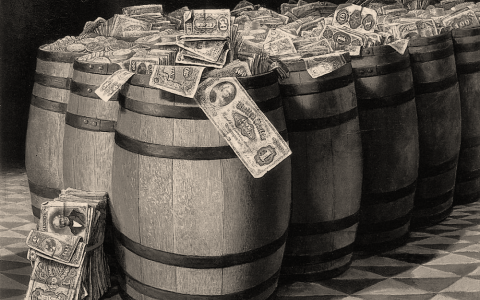
Diplomatic tension should drive oil prices up, not down. If the cartel era is over, the $300 billion sovereign fund pivots to the front line of policy.
It’s looking a lot like 2014 in the oil market. Once again, prices have dropped far below OPEC’s comfort zone as a new generation of competitors keep pumping crude.
The sense of deja vu feels more like dread. That wasn’t a fun season for investors and this one could be worse.
After all, four years ago we knew the limits of the role Saudi Arabia would play. Now the situation is a lot more fluid.
Flashback to an oil crash
The commodity market can be opaque to non-specialists. All I really remember about the long 2014 oil bust was that it looked like normal volatility in the early phases.
Petroleum futures peaked above $100 that winter and then dropped to $75 as the weather warmed up.
But in Thanksgiving week, when we’d normally expect a little support, oil went over a cliff and didn’t hit bottom for another 15 months.
Again, it looked like the normal noise of holiday trading. Turnover dropped, exaggerating volatility.
Three months later, people were openly wondering whether Big Oil was going to default on its debt and trigger a second 2008-style credit crunch.
We now know that didn’t happen. The lenders survived. U.S. shale survived. The world didn’t end.
But in the meantime it sometimes looked like it. Institutions dumped banks, pipelines, railroads, home builders, even hotel chains exposed to oil country.
And it took OPEC years to stop the bleeding. That’s why all eyes are on Saudi Arabia this time around.
The Saudis generally have all the surplus production capacity that matters. When they want to move the oil market, one way or another they get what they want.
Four years ago, the theory was that they let crude slide below $25 in order to shake out marginal competitors.
This time it just isn’t clear. I’m not convinced Trump has talked them down to give U.S. consumers a lift.
After all, every $1 discount on each barrel costs the Saudis $10 million a day, $300 million a month. Unless there’s some deeper motive, altruism is unlikely here.
Remember, the kingdom can cut output at any time. They’re waiting for next week’s OPEC summit before making any public moves.
While we wait, Wall Street twists.
Reputation control: kingdom versus cartel
Crown Prince Mohammed bin Salman has a vested interest in looking like a nice guy right now, of course.
Tightening the spigot gives other governments an incentive to withhold investments the country needs to modernize its economy.
Besides, the higher oil prices get, the easier it is for substitute vendors to operate.
Europe could theoretically run on bio fuels at this point. And countries like Iran are always eager to step up whenever the world’s appetite for energy oversteps moral concerns.
By letting the world have all the fuel it can handle at this price, the Saudis keep their rivals running lean.
They hate the Iranians. Even if that country sidesteps new sanctions, $50 a barrel isn’t going to be a windfall.
Likewise, tension around the Gulf has stretched OPEC to the breaking point.
In theory the cartel should act with one vision for the benefit of all members. Now it looks increasingly like the Saudis using it to punish everyone else.
After all, we’re watching oil drop at a moment when Libyan production is disrupted and Iran is barely in the market.
And while Russia is a key player, the weekend’s hostilities in the Black Sea barely inspired a bounce and not a shock price spike.
Meanwhile U.S. producers keep drilling. Technology makes existing wells more efficient and opens up new fields.
The cartel was already fracturing. Wielding it as a weapon on behalf of its strongest member only accelerates the process.
Of course a world without OPEC is less predictable than the one we’ve known for decades. Wall Street hates unpredictability, especially when so many other fear factors are already on screen.
Whatever happens, I suspect we’ll see volatility return to the oil market in a big way. Those stocks will swing in the old boom and bust cycle.
Oil diplomacy by other means
The Saudis also have $300 billion in their sovereign investment fund.
That fund is heavily weighted to Big Tech and next-generation venture capital. When Silicon Valley shakes, the sovereign fund shudders.
Twitter, Tesla and all the usual suspects are well represented. Blackrock runs a lot of the money.
Then there’s roughly $200 billion in Treasury paper within the kingdom’s currency reserves. It isn’t a big piece of the bond market, but it’s more of a shield than a weapon.
Of course floating the national oil company would generate a lot of cash. That process has stalled and may never happen at this point.
Three years from now, where will Saudi oil be?



